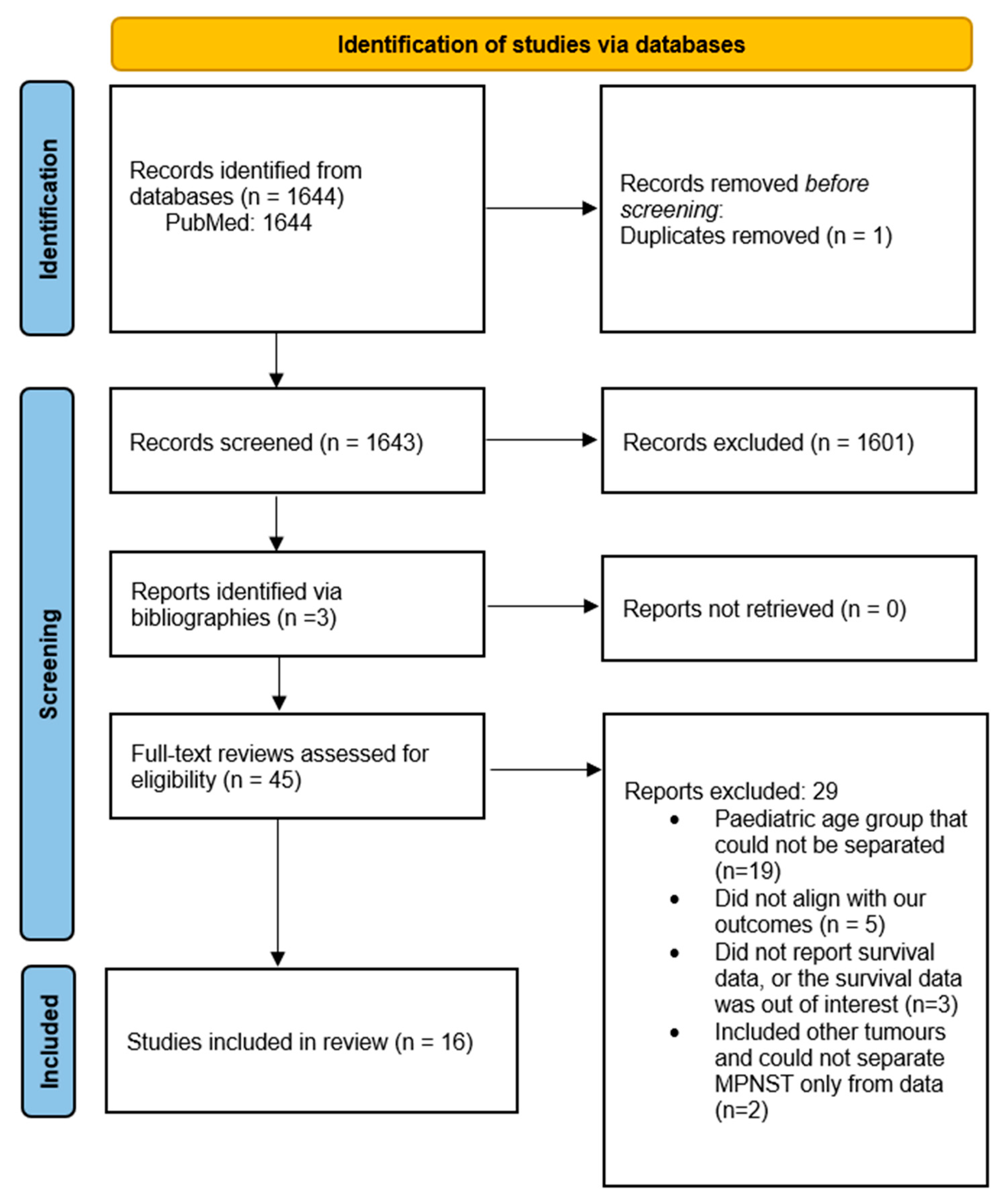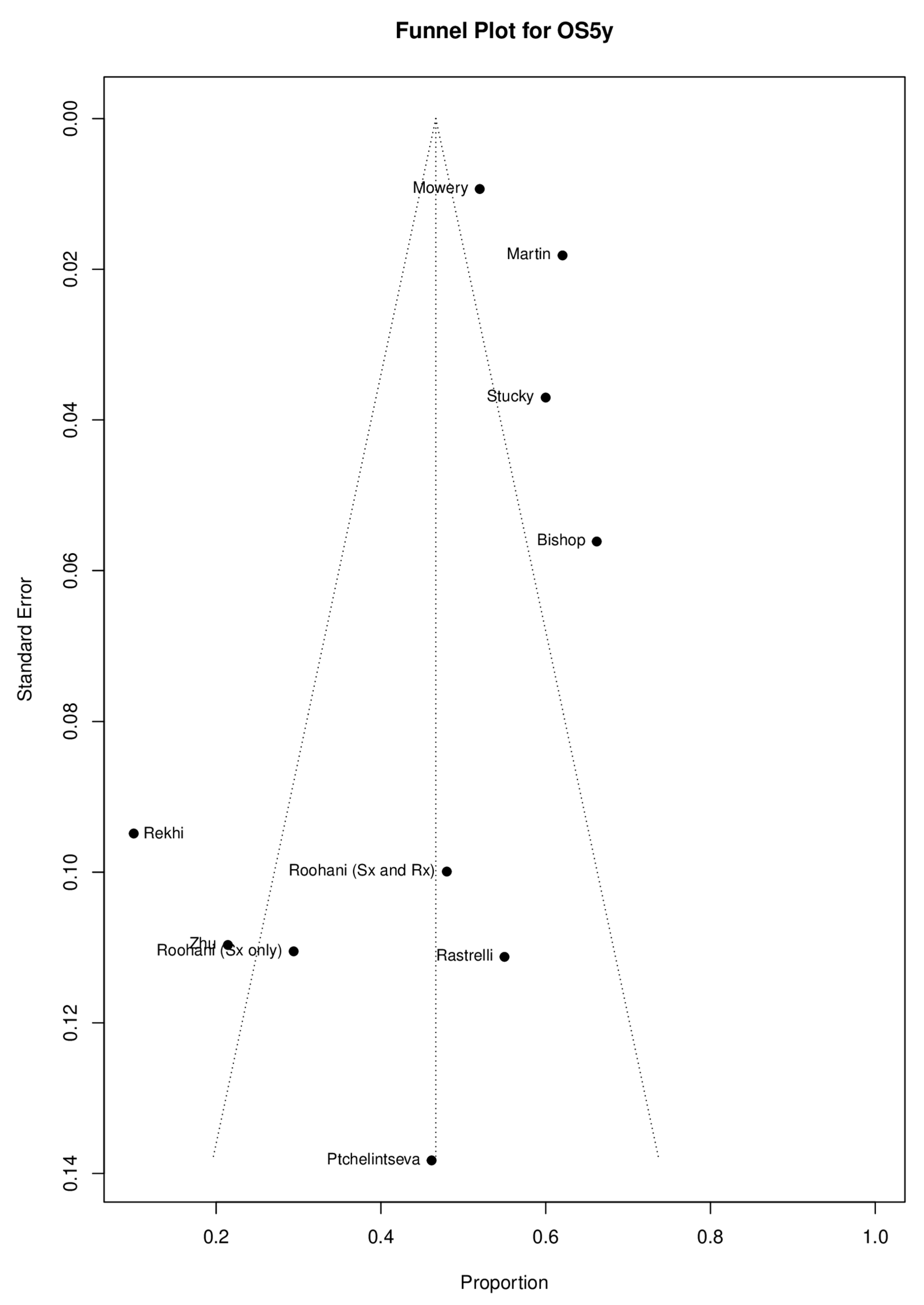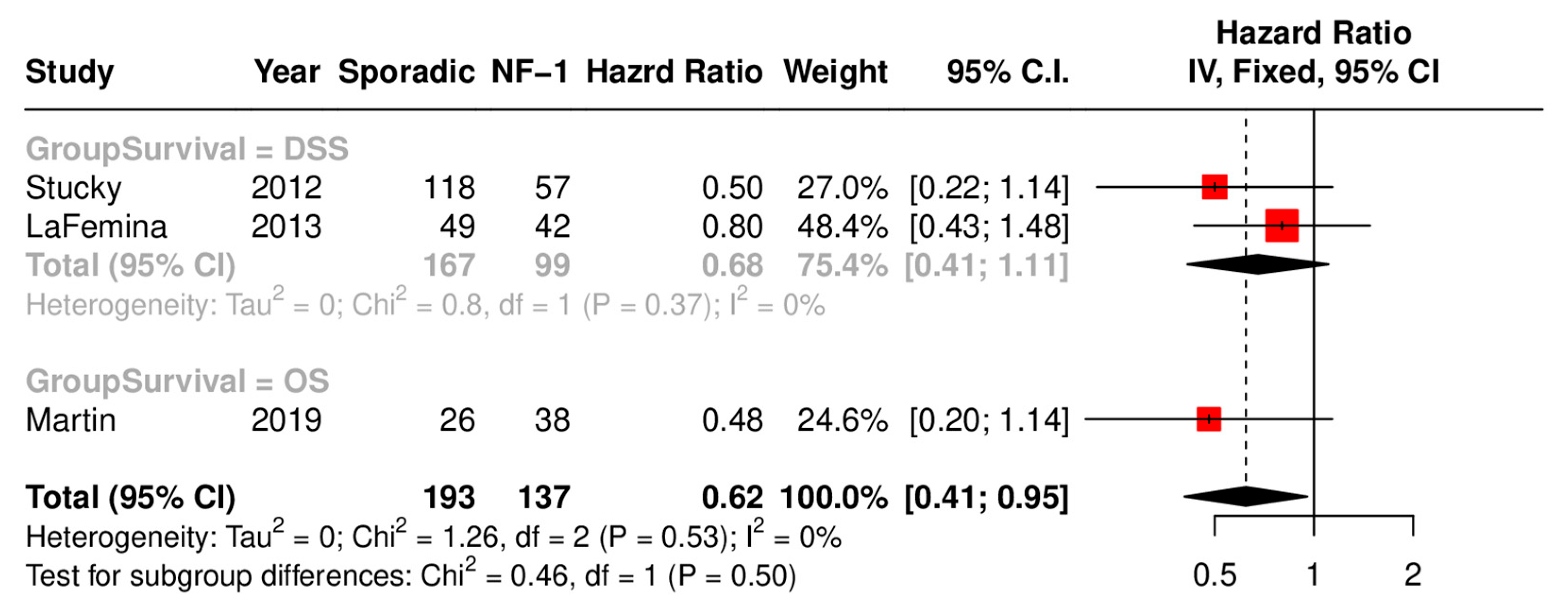An Assessment of Surgical Outcomes in Malignant Peripheral Nerve Sheath Tumors: A Systematic Review and Meta-Analysis of Surgical Interventions
Simple Summary
Abstract
1. Introduction
2. Materials and Methods
2.1. Data Sources and Search Strategy
2.2. Eligibility Criteria
2.3. Study Selection
2.4. Data Extraction
2.5. Statistical Analysis
2.6. Ethical Oversight
3. Results
3.1. Search Results and Study Selection
3.2. Demographic and Clinical Characteristics of Patients in the Reviewed Studies
3.3. Proportional Survival Results
3.4. NF-1 Subgroup
3.5. NF-1 vs. Sporadic Cases
4. Discussion
4.1. Survival and Clinical Features
4.2. Tumor Relapse and Recurrence
4.3. NF-1 vs. Sporadic Cases
4.4. Heterogeneity in Survival Outcomes
4.5. Study Limitations
5. Conclusions
Supplementary Materials
Author Contributions
Funding
Institutional Review Board Statement
Informed Consent Statement
Data Availability Statement
Conflicts of Interest
Abbreviations
| MPNST | Malignant Peripheral Nerve Sheath Tumors |
| NF1 | Neurofibromatosis Type 1 |
| PFS | Progression-free Survival |
| OS | Overall Survival |
| DSS | Disease-specific Survival |
| HR | Hazard Ratio |
| CI | Confidence Interval |
| EGFR | Epidermal Growth Factor Receptor |
References
- Evans, D.G.R.; E Baser, M.; McGaughran, J.; Sharif, S.; Howard, E.; Moran, A. Malignant peripheral nerve sheath tumours in neurofibromatosis 1. J. Med Genet. 2002, 39, 311–314. [Google Scholar] [CrossRef]
- Uusitalo, E.; Rantanen, M.; Kallionpää, R.A.; Pöyhönen, M.; Leppävirta, J.; Ylä-Outinen, H.; Riccardi, V.M.; Pukkala, E.; Pitkäniemi, J.; Peltonen, S.; et al. Distinctive Cancer Associations in Patients With Neurofibromatosis Type 1. J. Clin. Oncol. 2016, 34, 1978–1986. [Google Scholar] [CrossRef] [PubMed]
- Bradford, D.; Kim, A. Current Treatment Options for Malignant Peripheral Nerve Sheath Tumors. Curr. Treat. Options Oncol. 2015, 16, 1–8. [Google Scholar] [CrossRef]
- Farid, M.; Demicco, E.G.; Garcia, R.; Ahn, L.; Merola, P.R.; Cioffi, A.; Maki, R.G. Malignant Peripheral Nerve Sheath Tumors. Oncologist. 2014, 19, 193–201. [Google Scholar] [CrossRef] [PubMed]
- Levi, A.D.; Ross, A.L.; Cuartas, E.; Qadir, R.; Temple, H.T. The Surgical Management of Symptomatic Peripheral Nerve Sheath Tumors. Neurosurgery 2010, 66, 833–840. [Google Scholar] [CrossRef] [PubMed]
- Dunn, G.P.; Spiliopoulos, K.; Plotkin, S.R.; Hornicek, F.J.; Harmon, D.C.; Delaney, T.F.; Williams, Z. Role of resection of malignant peripheral nerve sheath tumors in patients with neurofibromatosis Type 1. J. Neurosurg. 2013, 118, 142–148. [Google Scholar] [CrossRef]
- Lucas, C.-H.G.; Vasudevan, H.N.; Chen, W.C.; Magill, S.T.; E Braunstein, S.; Jacques, L.; Dahiya, S.; Rodriguez, F.J.; E Horvai, A.; Perry, A.; et al. Histopathologic findings in malignant peripheral nerve sheath tumor predict response to radiotherapy and overall survival. Neuro-Oncology Adv. 2020, 2, vdaa131. [Google Scholar] [CrossRef]
- Brekke, H.R.; Kolberg, M.; Skotheim, R.I.; Hall, K.S.; Bjerkehagen, B.; Risberg, B.; Domanski, H.A.; Mandahl, N.; Liestøl, K.; Smeland, S.; et al. Identification of p53 as a strong predictor of survival for patients with malignant peripheral nerve sheath tumors. Neuro-Oncology 2009, 11, 514–528. [Google Scholar] [CrossRef]
- Sobczuk, P.; Teterycz, P.; Czarnecka, A.M.; Świtaj, T.; Koseła-Paterczyk, H.; Kozak, K.; Falkowski, S.; Rutkowski, P. Systemic Treatment for Advanced and Metastatic Malignant Peripheral Nerve Sheath Tumors—A Sarcoma Reference Center Experience. J. Clin. Med. 2020, 9, 3157. [Google Scholar] [CrossRef]
- Zhu, B.; Liu, X.; Liu, Z.; Yang, S.; Liao, H.-I.; Jiang, L.; Wei, F. Malignant peripheral nerve sheath tumours of the spine: Clinical manifestations, classification, treatment, and prognostic factors. Eur. Spine J. 2011, 21, 897–904. [Google Scholar] [CrossRef][Green Version]
- Prudner, B.C.; Ball, T.; Rathore, R.; Hirbe, A.C. Diagnosis and management of malignant peripheral nerve sheath tumors: Current practice and future perspectives. Neuro-Oncology Adv. 2019, 2, i40–i49. [Google Scholar] [CrossRef] [PubMed]
- Automeris. WebPlotDigitizer. Available online: https://automeris.io/wpd/ (accessed on 17 July 2024).
- RStudio Team. RStudio: Integrated Development for R. RStudio, PBC: Boston, MA, USA, 2020; Available online: http://www.rstudio.com/ (accessed on 6 April 2025).
- Tierney, J.F.; Stewart, L.A.; Ghersi, D.; Burdett, S.; Sydes, M.R. Practical methods for incorporating summary time-to-event data into meta-analysis. Trials 2007, 8, 16. [Google Scholar] [CrossRef] [PubMed]
- Barker, T.H.; Migliavaca, C.B.; Stein, C.; Colpani, V.; Falavigna, M.; Aromataris, E.; Munn, Z. Conducting proportional meta-analysis in different types of systematic reviews: A guide for synthesisers of evidence. BMC Med Res. Methodol. 2021, 21, 1–9. [Google Scholar] [CrossRef] [PubMed]
- Cai, Z.; Tang, X.; Liang, H.; Yang, R.; Yan, T.; Guo, W. Prognosis and risk factors for malignant peripheral nerve sheath tumor: A systematic review and meta-analysis. World J. Surg. Oncol. 2020, 18, 1–12. [Google Scholar] [CrossRef]
- Martin, E.; Coert, J.H.; Flucke, U.E.; Slooff, W.-B.M.; Ho, V.K.; van der Graaf, W.T.; van Dalen, T.; van de Sande, M.A.; van Houdt, W.J.; Grünhagen, D.J.; et al. A nationwide cohort study on treatment and survival in patients with malignant peripheral nerve sheath tumours. Eur. J. Cancer 2020, 124, 77–87. [Google Scholar] [CrossRef]
- Sharma, M.R.; Puj, K.S.; Salunke, A.A.; Pandya, S.J.; Gandhi, J.S.; Parikh, A.R. Malignant peripheral nerve sheath tumor with analysis of various prognostic factors: A single-institutional experience. J. Cancer Res. Ther. 2021, 17, 106–113. [Google Scholar] [CrossRef]
- Mowery, A.; Clayburgh, D. Malignant peripheral nerve sheath tumors: Analysis of the national cancer database. Oral Oncol. 2019, 98, 13–19. [Google Scholar] [CrossRef]
- Zehou, O.; Fabre, E.; Zelek, L.; Sbidian, E.; Ortonne, N.; Banu, E.; Wolkenstein, P.; Valeyrie-Allanore, L. Chemotherapy for the treatment of malignant peripheral nerve sheath tumors in neurofibromatosis 1: A 10-year institutional review. Orphanet J. Rare Dis. 2013, 8, 127. [Google Scholar] [CrossRef]
- Wong, W.W.; Hirose, T.; Scheithauer, B.W.; Schild, S.E.; Gunderson, L.L. Malignant peripheral nerve sheath tumor: Analysis of treatment outcome. Int. J. Radiat. Oncol. 1998, 42, 351–360. [Google Scholar] [CrossRef]
- Anghileri, M.; Miceli, R.; Fiore, M.; Mariani, L.; Ferrari, A.; Mussi, C.; Lozza, L.; Collini, P.; Olmi, P.; Casali, P.; et al. Malignant peripheral nerve sheath tumors: Prognostic factors and survival in a series of patients treated at a single institution. Cancer 2006, 107, 1065–1074. [Google Scholar] [CrossRef]
- Kahn, J.; Gillespie, A.; Tsokos, M.; Ondos, J.; Dombi, E.; Camphausen, K.; Widemann, B.C.; Kaushal, A. Radiation Therapy in Management of Sporadic and Neurofibromatosis Type 1-Associated Malignant Peripheral Nerve Sheath Tumors. Front. Oncol. 2014, 4, 324. [Google Scholar] [CrossRef] [PubMed]
- van Noesel, M.M.; Orbach, D.; Brennan, B.; Kelsey, A.; Zanetti, I.; de Salvo, G.L.; Gaze, M.N.; Craigie, R.J.; McHugh, K.; Francotte, N.; et al. Outcome and prognostic factors in pediatric malignant peripheral nerve sheath tumors: An analysis of the European Pediatric Soft Tissue Sarcoma Group (EpSSG) NRSTS-2005 prospective study. Pediatr. Blood Cancer 2019, 66, e27833. [Google Scholar] [CrossRef]
- Watson, K.L.; Al Sannaa, G.A.; Kivlin, C.M.; Ingram, D.R.; Landers, S.M.; Roland, C.L.; Cormier, J.N.; Hunt, K.K.; Feig, B.W.; Ashleigh Guadagnolo, B.; et al. Patterns of recurrence and survival in sporadic, neurofibromatosis Type 1-associated, and radia-tion-associated malignant peripheral nerve sheath tumors. J. Neurosurg. 2017, 126, 319–329. [Google Scholar] [CrossRef] [PubMed]
- Stucky, C.-C.H.; Johnson, K.N.; Gray, R.J.; Pockaj, B.A.; Ocal, I.T.; Rose, P.S.; Wasif, N. Malignant Peripheral Nerve Sheath Tumors (MPNST): The Mayo Clinic Experience. Ann. Surg. Oncol. 2011, 19, 878–885. [Google Scholar] [CrossRef] [PubMed]
- Ducatman, B.S.; Scheithauer, B.W.; Piepgras, D.G.; Reiman, H.M.; Ilstrup, D.M. Malignant peripheral nerve sheath tumors. A clinicopathologic study of 120 cases. Cancer 1986, 57, 2006–2021. [Google Scholar] [CrossRef]
- Miao, R.; Wang, H.; Jacobson, A.; Lietz, A.P.; Choy, E.; Raskin, K.A.; Schwab, J.H.; Deshpande, V.; Nielsen, G.P.; DeLaney, T.F.; et al. Radiation-induced and neurofibromatosis-associated malignant peripheral nerve sheath tumors (MPNST) have worse outcomes than sporadic MPNST. Radiother. Oncol. 2019, 137, 61–70. [Google Scholar] [CrossRef]
- Wakeman, K.M.; Zhang, Q.S.; Bandhlish, A.; Cranmer, L.D.; Ricciotti, R.W.; Mantilla, J.G. Fédération Nationale Des Centres de Lutte Contre Le Cancer (FNCLCC) Grading, Margin Status and Tumor Location Associate With Survival Outcomes in Malignant Peripheral Nerve Sheath Tumors. Am. J. Clin. Oncol. 2021, 45, 28–35. [Google Scholar] [CrossRef]
- Collin, C.; Godbold, J.; Hajdu, S.; Brennan, M. Localized extremity soft tissue sarcoma: An analysis of factors affecting survival. Am. J. Clin. Oncol. 2022, 45, 28–35. [Google Scholar] [CrossRef] [PubMed]
- Akshintala, S.; Mallory, N.C.; Lu, Y.; Ballman, K.V.; Schuetze, S.M.; Chugh, R.; Maki, R.G.; Reinke, D.K.; Widemann, B.C.; Kim, A. Outcome of Patients With Malignant Peripheral Nerve Sheath Tumors Enrolled on Sarcoma Alliance for Research Through Collaboration (SARC) Phase II Trials. Oncol. 2023, 28, 453–459. [Google Scholar] [CrossRef]
- Stark, A.M.; Buhl, R.; Hugo, H.H.; Mehdorn, H.M. Malignant peripheral nerve sheath tumours--report of 8 cases and review of the literature. Acta Neurochir. 2001, 143, 357–363. [Google Scholar] [CrossRef]
- Robinson, M.; Barr, L.; Fisher, C.; Fryatt, I.; Stotter, A.; Harmer, C.; Wiltshaw, E.; Westbury, G. Treatment of extremity soft tissue sarcomas with surgery and radiotherapy. Radiother. Oncol. 1990, 18, 221–233. [Google Scholar] [CrossRef] [PubMed]
- Ma, C.; Ow, A.; Shan, O.; Wu, Y.; Zhang, C.; Sun, J.; Ji, T.; Martin, L.P.; Wang, L. Malignant peripheral nerve sheath tumours in the head and neck region: Retrospective analysis of clinicopathological features and treatment outcomes. Int. J. Oral Maxillofac. Surg. 2014, 43, 924–932. [Google Scholar] [CrossRef] [PubMed]
- Cao, Y.; Wang, Y.-B.; Bai, Y.; Tan, X.-Y.; Ma, C.-Y.; Chen, Y.; Yu, H.-Q.; Xu, H.-Y.; Zhao, G. Epidemiology, Characteristic, and Prognostic Factors of Primary Sporadic Intradural Malignant Peripheral Nerve Sheath Tumor in the Spinal Canal: A Systematic Literature Review. Front. Oncol. 2022, 12, 911043. [Google Scholar] [CrossRef] [PubMed]
- Lim, Z.; Gu, T.Y.; Tai, B.C.; Puhaindran, M.E. Survival outcomes of malignant peripheral nerve sheath tumors (MPNSTs) with and without neurofibromatosis type I (NF1): A meta-analysis. World J. Surg. Oncol. 2024, 22, 1–14. [Google Scholar] [CrossRef]
- Hruban, R.H.; Shiu, M.H.; Senie, R.T.; Woodruff, J.M. Malignant peripheral nerve sheath tumors of the buttock and lower extremity. A study of 43 cases. Cancer 1990, 66, 1253–1265. [Google Scholar] [CrossRef]
- Tabone-Eglinger, S.; Bahleda, R.; Côté, J.-F.; Terrier, P.; Vidaud, D.; Cayre, A.; Beauchet, A.; Théou-Anton, N.; Terrier-Lacombe, M.-J.; Lemoine, A.; et al. Frequent EGFR Positivity and Overexpression in High-Grade Areas of Human MPNSTs. Sarcoma 2008, 2008, 1–7. [Google Scholar] [CrossRef]



| Number of Studies | Sample Size | Frequency, (%) Within the Sample Size | |
|---|---|---|---|
| Age (years); M ± SD | 15 | 3539 | 46.91 ± 1.99 |
| Sex | 15 | 4234 | |
| Male | 2284 (53.7) | ||
| Female | 1950 (46.3) | ||
| Tumor Characteristics | |||
| Size (cm3); M ± SD | 8 | 3258 | 7.65 ± 1.07 |
| Tumor Location | |||
| Trunk/Extremity | 14 | 4191 | 3239 (77.3) |
| Trunk | 13 | 1333 | 553 (41.5) |
| Extremity | 12 | 1310 | 567 (43.3) |
| Head/Neck | 12 | 4177 | 543 (13) |
| Other | 4 | 3099 | 414 (13.4) |
| Grade | 11 | 3434 | |
| Low | 1038 (30.2) | ||
| High | 2396 (69.8) | ||
| Pre-op Symptoms | |||
| Mass | 3 | 54 | 43 (79.7) |
| Pain | 2 | 44 | 27 (61.4) |
| Neurofibromatosis-1 (NF-1) | 14 | 1375 | 438 (32.0) |
| Metastasis on presentation | 13 | 4109 | 699 (17.0) |
| Treatment Protocol | 14 | 3434 | |
| Surgery | 2354 (68.5) | ||
| Gross Total Resection | 12 | 2354 | 1708 (72.6) |
| Chemotherapy | 1739 (50.6) | ||
| Radiation | 1763 (51.3) | ||
| Outcomes | |||
| Tumor Recurrence | 11 | 445 | 249 (56.0) |
| Local | 176 (70.6) | ||
| Distant | 73 (29.4) | ||
| Mean Follow-up; M ± SD | 10 | 3423 | 33.53 ± 16.34 |
| Mortality Rate | 10 | 3342 | 1685 (50.4) |
| Studied Outcome | End-Point, Years | No. of Patients | # of Studies | Pooled Proportion | 95% CI | I2 | p-Value | p-Value for Subgroup Difference | |
|---|---|---|---|---|---|---|---|---|---|
| Progression-Free Survival | PFS | 1 | 166 | 4 | 0.61 | [0.25, 0.98] | 98% | <0.01 | - |
| PFS | 3 | 41 | 2 | 0.62 | [0.35, 0.89] | 72% | 0.06 | - | |
| PFS | 5 | 41 | 2 | 0.62 | [0.35, 0.89] | 72% | 0.06 | - | |
| Patient Survival | OS | 1 | 3072 | 8 | 0.86 | [0.75, 0.97] | 89% | <0.01 | - |
| OS | 3 | 2947 | 6 | 0.60 | [0.45, 0.75] | 80% | <0.01 | - | |
| OS and DSS | 5 | 3917 | 10 | 0.47 | [0.35, 0.58] | 87% | <0.01 | 0.04 | |
| Neurofibromatosis-1 (NF-1) Cohort | |||||||||
| Patient Survival | OS and DSS | 1 | 120 | 3 | 0.93 | [0.83, 1.00] | 77% | 0.01 | 0.12 |
| DSS | 3 | 99 | 2 | 0.68 | [0.53; 0.84] | 65% | 0.09 | - | |
| OS and DSS | 5 | 181 | 5 | 0.50 | [0.31, 0.68] | 86% | <0.01 | 0.13 | |
Disclaimer/Publisher’s Note: The statements, opinions and data contained in all publications are solely those of the individual author(s) and contributor(s) and not of MDPI and/or the editor(s). MDPI and/or the editor(s) disclaim responsibility for any injury to people or property resulting from any ideas, methods, instructions or products referred to in the content. |
© 2025 by the authors. Licensee MDPI, Basel, Switzerland. This article is an open access article distributed under the terms and conditions of the Creative Commons Attribution (CC BY) license (https://creativecommons.org/licenses/by/4.0/).
Share and Cite
Al-Mistarehi, A.-H.; Zaitoun, K.J.; Khalifeh, J.; Saint-Germain, M.A.; Horowitz, M.A.; Ghaith, A.K.; Foster, C.H.; Braverman, S.; Albert, A.N.; AlDallal, U.; et al. An Assessment of Surgical Outcomes in Malignant Peripheral Nerve Sheath Tumors: A Systematic Review and Meta-Analysis of Surgical Interventions. Cancers 2025, 17, 1997. https://doi.org/10.3390/cancers17121997
Al-Mistarehi A-H, Zaitoun KJ, Khalifeh J, Saint-Germain MA, Horowitz MA, Ghaith AK, Foster CH, Braverman S, Albert AN, AlDallal U, et al. An Assessment of Surgical Outcomes in Malignant Peripheral Nerve Sheath Tumors: A Systematic Review and Meta-Analysis of Surgical Interventions. Cancers. 2025; 17(12):1997. https://doi.org/10.3390/cancers17121997
Chicago/Turabian StyleAl-Mistarehi, Abdel-Hameed, Khaled J. Zaitoun, Jawad Khalifeh, Max A. Saint-Germain, Melanie Alfonzo Horowitz, Abdul Karim Ghaith, Chase H. Foster, Shoshana Braverman, Avi N. Albert, Usama AlDallal, and et al. 2025. "An Assessment of Surgical Outcomes in Malignant Peripheral Nerve Sheath Tumors: A Systematic Review and Meta-Analysis of Surgical Interventions" Cancers 17, no. 12: 1997. https://doi.org/10.3390/cancers17121997
APA StyleAl-Mistarehi, A.-H., Zaitoun, K. J., Khalifeh, J., Saint-Germain, M. A., Horowitz, M. A., Ghaith, A. K., Foster, C. H., Braverman, S., Albert, A. N., AlDallal, U., Belzberg, A., Lee, S., Theodore, N., Laufer, I., & Lubelski, D. (2025). An Assessment of Surgical Outcomes in Malignant Peripheral Nerve Sheath Tumors: A Systematic Review and Meta-Analysis of Surgical Interventions. Cancers, 17(12), 1997. https://doi.org/10.3390/cancers17121997






